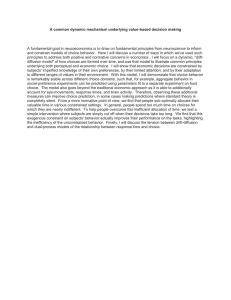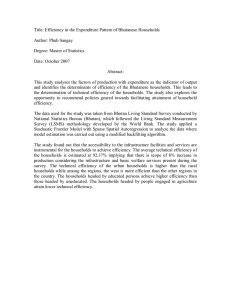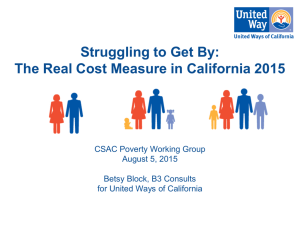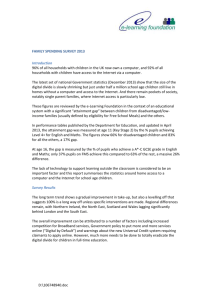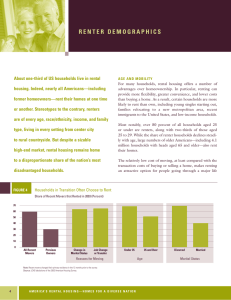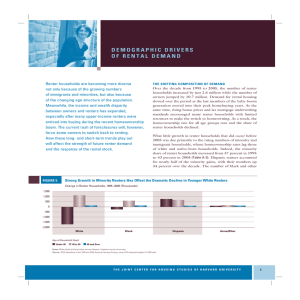Discussion of “From Shirtsleeves to Shirtsleeves in a Long Lifetime”
advertisement
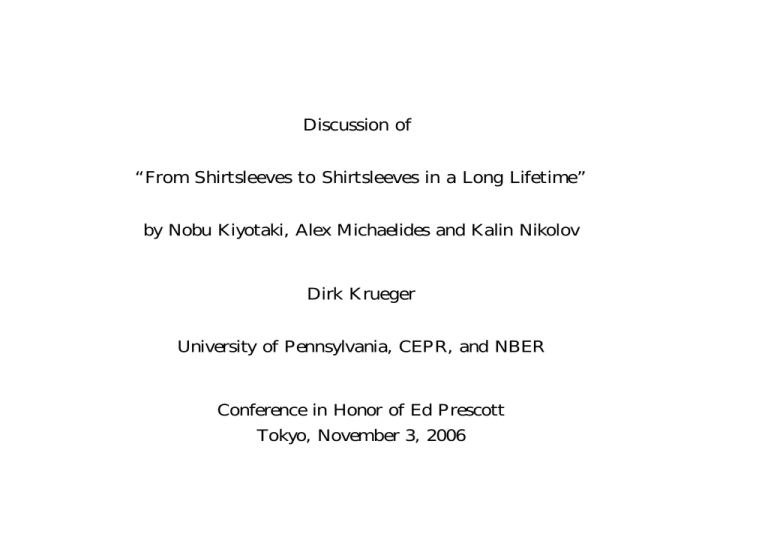
Discussion of “From Shirtsleeves to Shirtsleeves in a Long Lifetime” by Nobu Kiyotaki, Alex Michaelides and Kalin Nikolov Dirk Krueger University of Pennsylvania, CEPR, and NBER Conference in Honor of Ed Prescott Tokyo, November 3, 2006 Purpose of the Paper • Construction of a quantitative theory that — captures the life cycle profile of the buying/renting decision — allows to study the determinants of house price changes (financial constraints, productivity growth etc.) The Paper: Overview • Land as fixed factor in production of structures • Collateral constraints • Preference for buying over renting Relationship Between Model Elements and Desired Results Model Elem.\Questions Land as Fixed Factor Collateral Constraint Buy Preference Life Cycle Not Needed Needed Needed Price Changes Needed Needed Not Needed Question 3 Needed Needed Needed Key Model Elements: Technology • Final output production η Ct + It = Yt = (AtNt)1−η ZY,t • Production of structures ZY,t + ZR,t = Zt = Ktγ L1−γ • Capital accumulation Kt+1 = (1 − δ)Kt + It Key Model Elements: Population and Endowments • Households can be in one of five states: low (εl ), medium (εm) and high (εh) productivity, retired and dead. Transition matrix given by today\tom εl εm εh εl ω(1 − δl ) ωδl 0 εm 0 ω(1 − δm) ωδm 0 0 ω εh retired 0 0 0 dead 0 0 0 retired dead 1−ω 0 1−ω 0 1−ω 0 σ 1−σ 0 1 • GN − ω newborns of low productivity. GN = Nt/Nt−1 is population growth rate. Key Model Elements: Preferences • Standard time-separable expected utility with time discount factor β • Period utility function u(ct, ht) if household owns u(ct, (1 − ψ)ht) if household rents Key Model Elements: Financial Market Structure • Only financial asset is shares in real estate mutual fund (risk-free). Number of shares denoted by st. • Collateral constraint for home owners buying house of size ht θqtht ≤ qtst where θ can be interpreted as downpayment requirement. • Households may be renters, constrained homeowners or unconstrained homeowners. Main Results I: Life Cycle Profiles • Young, low productivity households do not find it optimal to save. Thus they remain renters and consume what they earn. Wait for productivity increase. Wear shirtsleeves. • Middle productivity households are first renters that save for downpayment. Then they become credit-constrained owners that expand their homes and finally become unconstrained owners. Same for high productivity households (do we need those?). • Retired households decumulate wealth since interest rate in general equilibrium is low, relative to time discount rate. Wear (less fashionable) shirtsleeves. Productivity increase, constrained house purchase 1.6 1.4 housing 1.2 1 0.8 shares 0.6 0.4 0.2 Unconstrained Retirement 0 1 5 9 13 17 21 25 29 33 37 41 45 49 53 57 61 65 69 Main Results II: Changes in Price of Real Estate (Steady State Comparisons) • Financial constraints important for home ownership rates, but not for real estate prices and quantities (mainly reallocation among owners and renters). • Increase in the importance of land in the production of structures: Large increase in housing prices and house price to rent ratios. This finding could be exploited empirically, both in a country cross-section and a time series within a country. Table 5 Column % of tenants % of constrained households % of unconstrained homeowners % of shares owned by tenants % of shares owned by constrained % of housing used by tenants % of housing used by constrained Current account as % of GDP Net foreign Assets as % of GDP Value of total structures to GDP Housing structures to total structures Value of housing to wages Housing price to rental rate Real return House price (N=An=1) Output (N=An=1) baseline 1 θ=0.1 2 θ=1.0 3 gn=1.02 4 ga=1.03 5 b=0.1 6 S*=0 7 γ=0.5 8 24.76 8.27 66.97 0.08 0.33 8.61 2.42 0.90 -19.49 2.98 0.45 2.50 8.65 6.62 1.66 1.11 2.59 25.49 71.92 0.02 0.36 0.76 8.05 0.89 -19.32 2.98 0.45 2.50 8.66 6.61 1.66 1.11 37.32 11.83 50.85 0.80 3.15 13.87 6.99 0.86 -18.77 2.99 0.45 2.50 8.69 6.58 1.66 1.11 42.35 11.76 45.88 0.93 3.73 17.26 8.30 1.93 -34.76 3.00 0.45 2.48 8.77 7.27 1.71 1.10 38.77 14.95 46.28 1.06 4.10 15.44 9.12 2.17 -42.69 2.83 0.45 2.35 8.31 7.69 1.67 1.09 21.10 15.12 63.78 1.07 2.70 6.74 5.98 0.14 -3.17 3.33 0.45 2.74 9.61 5.86 1.78 1.12 36.85 10.99 52.17 0.87 2.93 13.53 6.40 0.00 0.00 2.90 0.46 2.46 8.43 6.84 1.63 1.10 25.34 5.54 69.12 0.07 0.28 7.87 1.90 8.12 -137.70 5.18 0.48 4.49 13.89 7.54 4.95 0.89 γ=0.5 9 12.84 11.09 76.06 0.16 0.47 3.47 3.09 0.93 -13.26 4.49 0.51 4.22 11.86 8.64 4.40 0.88 A Great Question Their Model could Address • Substantial population aging predicted for the industrialized world. In many regions population will be shrinking (absent a change in migration policy). • Question: what the impacts of this massive change on the (future) price of real estate and the fraction of households renting. Who is gaining, who is losing? • Note: to answer this important question one needs exactly all three elements of their model population growth rate 0.03 US European Union Rest OECD Rest World 0.025 0.02 popgr 0.015 0.01 0.005 0 −0.005 −0.01 2000 2010 2020 2030 2040 Year 2050 2060 2070 2080 working age population ratio US European Union Rest OECD Rest World 0.85 wapr 0.8 0.75 0.7 0.65 0.6 2000 2010 2020 2030 2040 Year 2050 2060 2070 2080 Conjectured Results • Decline in the price of real estate • Decline in the value of land; capital loss for the owners of land • But: when does this decline start? Of course depends on when the severe aging of population enters information set of households. • Their model is a perfect laboratory to answer these questions.


